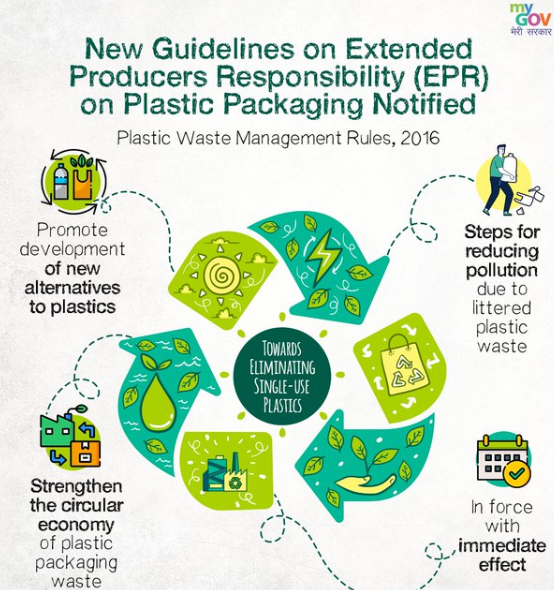India’s Rising e-waste
Syllabus
GS 3: Environment Pollution and degradation
Why in the News?
India’s e-waste surged by over 151% in six years, prompting debate around the effectiveness of the new EPR floor price, which aims to curb informal recycling and protect the environment.

Introduction
- India’s digital growth has led to a massive surge in electronic waste.
- While devices like smartphones and medical equipment power development, their disposal has become a crisis.
- Poor e-waste management causes environmental and economic losses.
- The floor price for EPR certificates is emerging as a vital solution for formalising recycling.
India’s Digital Growth and the E-Waste Challenge
- India is undergoing rapid digital transformation on the path to becoming a Viksit Bharat (developed nation).
- Increasing use of electronic devices, from mobile phones and laptops to industrial and medical tools is fuelling growth, innovation, and connectivity.
- However, this rising reliance on electronics generates a parallel stream of waste: electronic waste or e-waste.
- India now ranks among the top global e-waste generators, along with China, the United States, Japan, and Germany.
- E-waste in India has jumped by 151.03% in just six years.
- It increased from 7,08,445 metric tonnes in 2017–18 to 17,78,400 metric tonnes in 2023–24, with an annual growth rate of 1,69,283 metric tonnes.
What Is Extended Producer Responsibility (EPR)?
- EPR stands for Extended Producer Responsibility, a policy that mandates producers, importers, and brand owners to take responsibility for their products after end-of-life.
- It means manufacturers must manage the disposal, recycling, or reuse of their products even after consumers discard them.
- This responsibility includes:
- Reducing environmental impacts throughout the product lifecycle.Promoting eco-friendly designs.Including environmental costs in product pricing.
- Supporting efficient and formal waste management systems.
- EPR is crucial in shifting the waste burden away from municipalities and onto the producers who introduce electronic products to the market.
Impact of Improper E-Waste Management in India
- Mismanagement of e-waste creates environmental, health, social, and economic losses.
Environmental Losses:
- India loses more than $10 billion every year due to environmental pollution.
- Water pollution arises from the release of cyanide and sulphuric acid into water bodies.
- Air pollution results from burning of plastic and lead fumes.
- Soil pollution is caused by improper disposal of toxic materials.
Social Impact
- Informal, often illegal recycling practices dominate the sector.
- About 95% of e-waste is processed by unregulated workers, mainly women and children.
- These workers are exposed to harmful substances like mercury and lead without any safety measures.
- The average lifespan of informal e-waste workers is less than 27 years due to continuous toxic exposure.
Economic Loss
- Over ₹80,000 crore worth of valuable critical metals (like gold and copper) are lost annually due to inefficient and unsafe extraction methods.
- At least $20 billion is lost in tax revenue each year as the informal sector operates in cash and remains undocumented.
- Informal recycling deprives the economy of both materials and monetary value.
Need for a Floor Price in EPR Certificate System
- The E-waste (Management) Rules, 2022 introduced a floor price for EPR certificates.
- A floor price ensures minimum guaranteed returns for certified recyclers, providing economic security and encouraging safe practices.
It serves as a tool to:
- Discourage the informal sector by making formal recycling economically viable.
- Boost investment in recycling infrastructure.
- Make the formal system competitive enough to challenge the cost advantages of the informal sector.
- Unlock the value of critical metals like copper and gold through advanced technology.
How Floor Price Encourages Formalisation and Innovation
- Stable prices give recyclers the confidence to adopt advanced technologies and expand operations.
- A fair compensation mechanism motivates recyclers to prioritise material recovery over unsafe disposal.
- It turns e-waste from a liability into a valuable asset by recovering reusable resources.
- It ensures less e-waste reaches landfills and prevents toxins like mercury and lead from polluting soil and water.
- The global experience shows that EPR fees abroad are significantly higher than India’s current floor price.
- India must align with such global best practices to ensure meaningful outcomes.
- Floor pricing helps the system avoid failures experienced in other waste sectors like plastics, where low prices led to:
- Sham recyclers,Poor compliance, and
- A collapse of trust in the recycling framework.
Correcting Market Imbalance and Driving Compliance
- An effective floor price corrects the imbalance between formal and informal recyclers.
- It ensures that certified recyclers receive enough money to cover:
- Technological investment,Labour costs,
- Infrastructure upgrades.
- Producers meet their legal obligations through verifiable recycling practices, promoting compliance.
- A reliable pricing system avoids sudden market crashes where certificate prices fall drastically, causing recyclers to run out of money.
- Predictable pricing builds trust in the system, preventing it from degenerating into a chaotic, unregulated market.
Common Criticism and Counterarguments
- Some argue that setting a floor price will raise costs for producers and ultimately consumers.
- However, this view ignores the massive long-term costs of inaction:
- Health damage,Pollution clean-up,Loss of critical materials,
- Untaxed, unaccounted economic activity.
- Producers can reduce their compliance costs by designing longer-lasting and recyclable products.
- This aligns with the very goal of EPR to create sustainable production systems.
- Innovation is encouraged when fair prices reward efficient and environmentally sound recycling.
Lessons from the Plastic Waste Crisis
- The plastic waste sector’s failure due to low EPR prices is a cautionary example.
- It led to:
- Fraudulent recyclers,Collapse in trust,
- Failure to meet waste management goals.
- E-waste must not follow the same path. Stable pricing must ensure:
- Quality control,Real accountability,
- Viable operations for genuine recyclers.
Vision for E-Waste Recycling in India
- The floor price is not just an economic tool; it’s the foundation of a national recycling vision.
- It recognises recycling as a critical component of sustainability and economic efficiency.
- India must formalise its e-waste sector to:
- Prevent toxic exposure,Protect public health,
- Promote responsible use of scarce resources.
- The current rise in e-waste a 73% increase in just five years is a wake-up call.
- India can no longer afford to delay systemic reforms in e-waste recycling.
Turning E-Waste into Opportunity
- With a robust floor price mechanism:
- India can lead the world in responsible e-waste management.It can create new jobs in the formal recycling sector.
- It can significantly reduce pollution and environmental degradation.
- This will not only support the circular economy but also make sustainable growth a reality.
Conclusion
Introducing a floor price for EPR certificates is essential for formalising recycling, protecting the environment, and supporting India’s sustainable growth. It transforms e-waste into opportunity, ensuring long-term economic and ecological security.
Source:The Hindu
Mains Practice Question
Discuss the role of Extended Producer Responsibility (EPR) in addressing the challenges of e-waste management in India.






